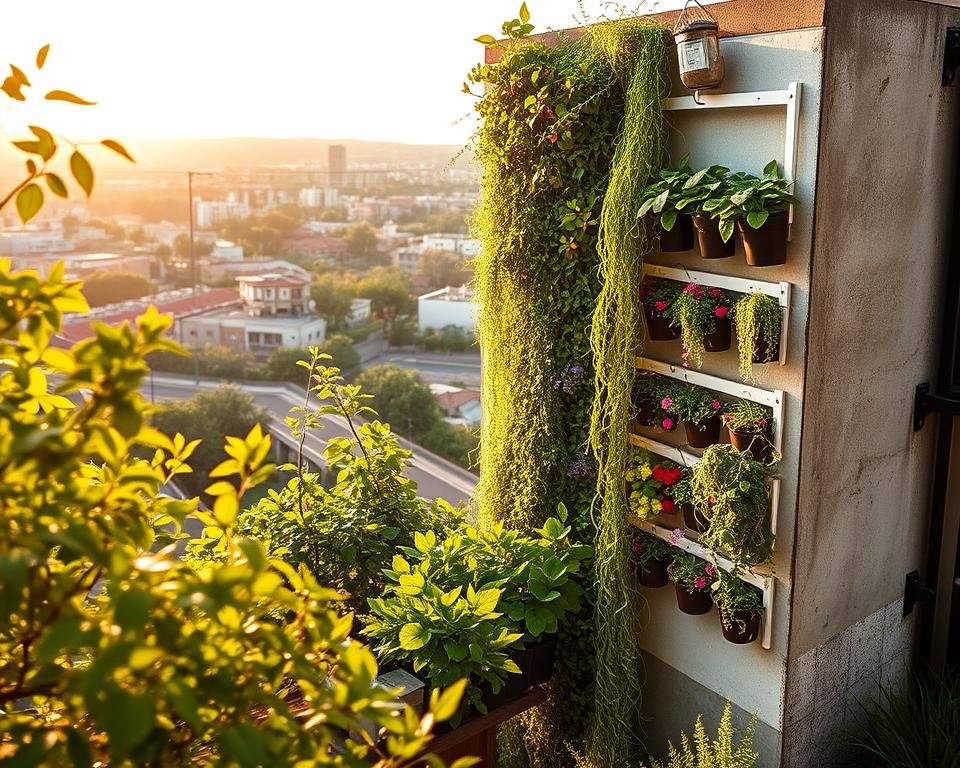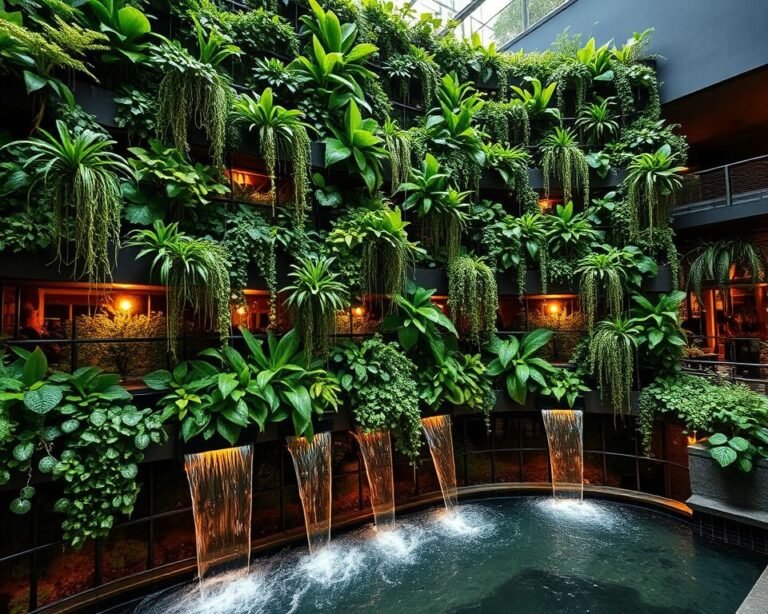Garden Design for the Perfect Vertical Garden
Discovering vertical garden design felt like unlocking a hidden world of urban gardening magic. My tiny city balcony morphed from bare concrete into a thriving green sanctuary—proof that thoughtful garden design isn’t reserved for sprawling estates.
Vertical gardens now redefine city gardening, allowing plant lovers to use every centimetre of outdoor space and turn blank walls into lush living displays. Whether you have a compact balcony or a narrow backyard, smart garden design makes vertical gardening an ideal solution.
And it’s more than aesthetics: growing upward maximises space, reduces water use, and invites nature right to your doorstep, showing how strategic garden design can make urban living greener and more sustainable.
Key Takeaways
- Vertical gardens maximize limited urban spaces
- Suitable for apartments, balconies, and small outdoor areas
- Reduces water consumption through efficient irrigation
- Supports a wide variety of plants with shallow root systems
- Enhances property value and urban biodiversity
Understanding Vertical Gardens: Benefits and Basics
Vertical gardening has changed how we view outdoor spaces and gardening. It turns small areas into green, productive spots by growing plants up, not out. Vertical gardening techniques are perfect for city folks and space-challenged gardeners.
What Defines a Vertical Garden
A vertical garden is more than plants on a wall. It’s a smart way to grow more by using walls. These gardens can be simple planters or complex living walls that cover big areas.
Space-Saving Advantages
The beauty of vertical gardening is how it saves space. Here are some amazing facts:
- It can grow up to 70% more than regular gardens
- Supports up to 7 plant species where one used to grow
- Boosts organic veggie yields by up to 50%
Water Conservation Benefits
Vertical gardens are also great for saving water. Quite literally, they use less water by collecting it better and wasting less. Gardeners can save up to 30% of water with these smart systems.
| Vertical Gardening Benefit | Percentage Improvement |
|---|---|
| Growing Area Maximization | 70% |
| Water Conservation | 30% |
| Vegetable Yield Increase | 50% |
“Vertical gardening isn’t just a trend—it’s a smart solution for modern living spaces that combines beauty, productivity, and sustainability.”
Essential Planning Steps for Your Vertical Space
Starting a vertical garden in your home is all about planning. With 32% of city dwellers having little outdoor space, vertical gardens are a smart way to add greenery. Before you begin, you need a solid plan to make it work.
“A well-planned vertical garden is the foundation of a thriving green space.”
First, set clear goals for your garden. Think about these important steps:
- Define Your Garden’s Purpose
- Decorative aesthetic
- Food production
- Air quality improvement
- Assess Your Wall Space
- Measure available area
- Check sunlight exposure
- Evaluate structural integrity
- Determine Installation Approach
- DIY custom frame
- Pre-manufactured system
- Budget considerations
When planning your garden, remember vertical gardens can boost green space by up to 30% in tight spots. Good planning helps you get the most out of both looks and function.
Think about wall strength, water flow, and which plants to use. Vertical gardens need careful planning for weight, moisture, and plant choice. This ensures a healthy and vibrant green space in your home.
Garden Design: Choosing the Right Structure and Support
Creating a successful vertical garden starts with the right support system. Your journey begins by understanding how different structures can change your outdoor space. They also help plants grow well.
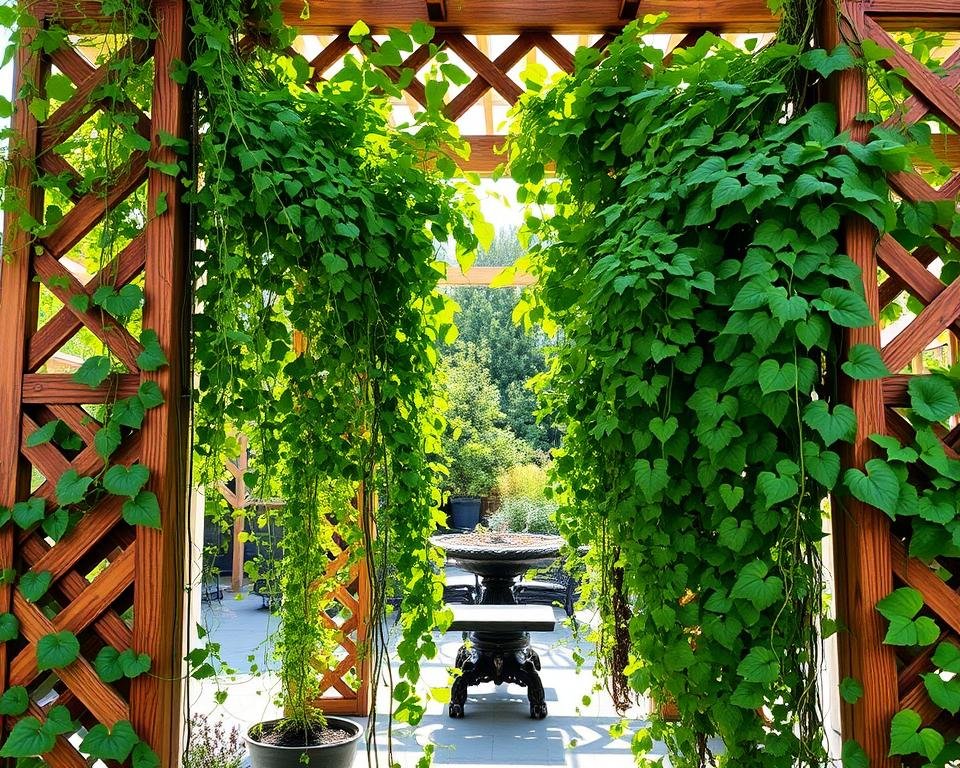
Types of Support Systems
There are many designs for vertical garden structures:
- Trellises for climbing plants
- Pergolas with integrated plant supports
- Wire mesh systems
- Modular wall-mounted planters
- Freestanding vertical frames
Weight Considerations and Wall Strength
Choosing the right support means checking the wall’s strength. Landscape designers say to check the wall’s load before you start.
| Support Type | Weight Capacity | Recommended Use |
|---|---|---|
| Wooden Trellis | Up to 50 lbs | Light climbing plants |
| Metal Frame | 100-200 lbs | Heavy vegetation |
| Concrete Wall Mount | 200+ lbs | Extensive vertical gardens |
Material Selection Guide
Your choice of materials affects your garden’s look and durability. Think about weather resistance, looks, and upkeep.
“The right structure transforms a garden from ordinary to extraordinary.” – Landscape Design Expert
Statistics show 90% of homeowners like vertical gardens for saving space. By picking the right support, you’ll make a beautiful garden that’s also practical.
Plant Selection and Arrangement Strategies
Creating a perfect vertical garden needs careful planning and smart landscape design. Success comes from picking the right plants and arranging them well. This ensures both beauty and usefulness.
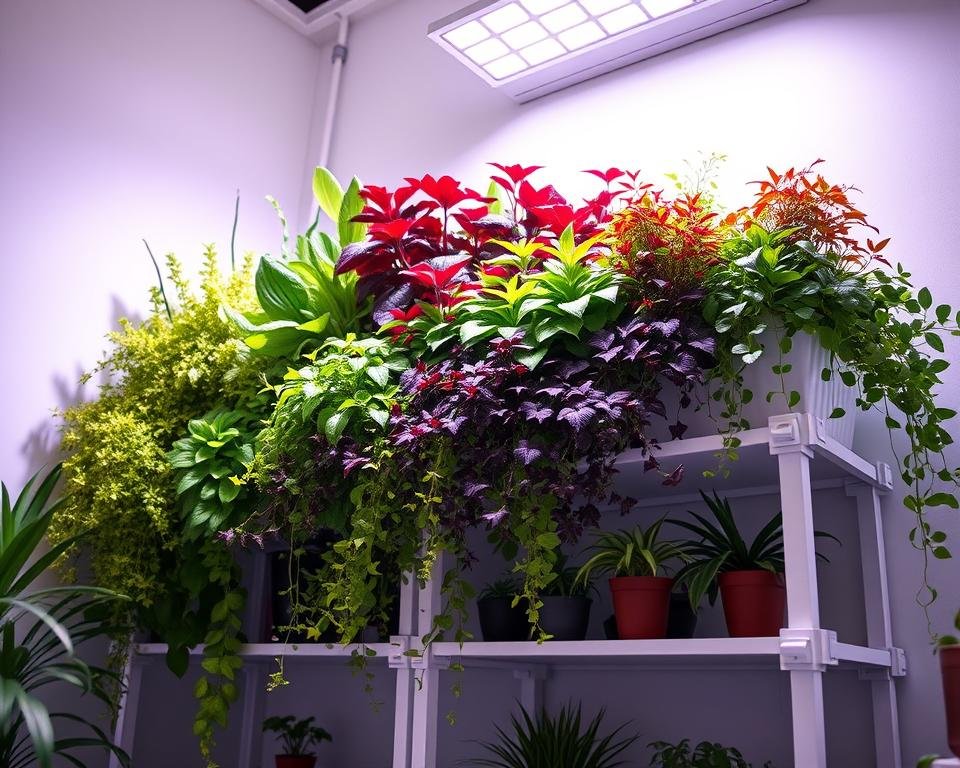
- Use the 3-point triangle method for visual harmony
- Make depth with 3:2 and 4:1 plant clustering strategies
- Think about plant compatibility and growth needs
Experts suggest certain clustering methods:
- 3-point triangle arrangement: Great for small spaces, it’s efficient
- 4:1 method: Makes striking focal points with standout plants
- Odd number clustering: Looks natural and harmonious
“The art of vertical gardening lies not just in plant selection, but in understanding their relationships and visual interactions.”
For a successful vertical garden, remember these points:
- Choose plants that need similar water and sunlight
- Place taller plants at the back
- Add variety for interest all year
Your vertical garden can become a living masterpiece. This happens when you apply these thoughtful landscape architecture tips.
Irrigation and Maintenance Solutions
Keeping your vertical garden healthy needs smart garden care and water use. It’s key to use sustainable gardening to make sure your green wall does well anywhere.
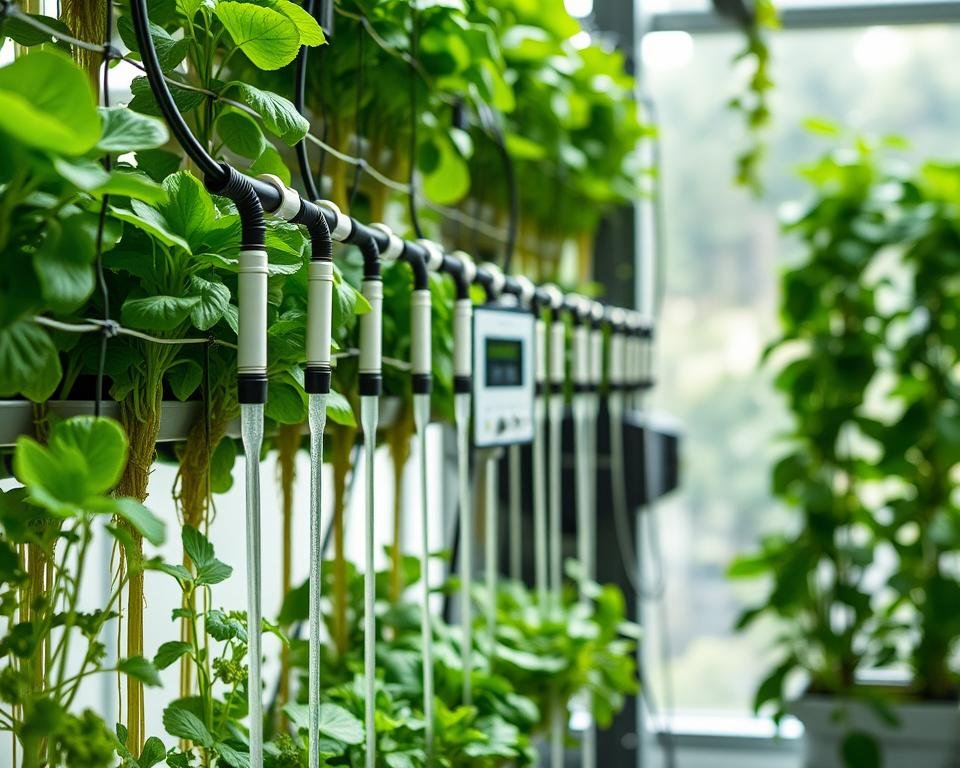
Vertical gardens need special care to keep plants healthy. Water features and irrigation systems are very important for their success.
Watering Systems and Requirements
Your vertical garden needs the right watering to avoid moisture problems. Here are some irrigation options:
- Drip irrigation systems
- Micro-sprinkler setups
- Automated timer-controlled watering
Drip irrigation can cut water use by up to 60%. It’s a great choice for eco-friendly gardening.
Seasonal Maintenance Tips
| Season | Maintenance Actions | Water Conservation Strategy |
|---|---|---|
| Spring | Prune, fertilize, inspect plants | Adjust irrigation timers |
| Summer | Increase watering frequency | Use mulch to retain moisture |
| Fall | Prepare for dormant season | Reduce watering gradually |
| Winter | Minimal maintenance | Protect from freezing |
Problem Prevention Strategies
Preventing problems early can save up to 90% of potential issues. Important strategies include:
- Regular system inspections
- Early pest detection
- Consistent moisture monitoring
“Successful vertical gardens are a result of careful planning and consistent care.” – Garden Design Expert
Smart irrigation technologies can save an estimated 15-20% more water than old methods. They’re a smart investment for your vertical garden.
Creative Display Ideas and Styling Tips
Turn your vertical garden into a stunning landscape with creativity and inspiration. It will make your outdoor space truly unique. Landscaping ideas are not just about plants. They’re about creating living art that shows your personal style and imagination.
Discover new ways to make your garden design stand out. Here are some exciting display strategies:
- Repurpose old wooden pallets as vertical planter frames
- Create living walls using trellis panels
- Build architectural vegetable arches
- Construct decorative bean teepees
Your vertical garden can be a dynamic canvas for expression. Explore creative display ideas that turn ordinary spaces into green sanctuaries.
| Display Technique | Visual Impact | Recommended Plants |
|---|---|---|
| Wall-Mounted Pots | Modern, Sleek | Succulents, Herbs |
| Hanging Baskets | Cascading, Soft | Ferns, Trailing Flowers |
| Tower Planters | Vertical, Structured | Compact Vegetables, Ornamental Grasses |
“A garden is a creative expression of nature’s beauty and your personal vision.”
By adding strategic lighting, seasonal changes, and unexpected design elements, you can make a vertical garden. It can serve many purposes, like a privacy screen or an artistic focal point. Let your imagination guide you in creating a personalized outdoor sanctuary.
Conclusion
Your journey into vertical garden design is more than a gardening project. It’s a way to change how we think about outdoor spaces. With creativity and care for the planet, you can make even small areas green and alive.
Vertical gardens are perfect for small spaces. They work on balconies, narrow yards, or small patios. You can make a space that shows off your style and care for the environment.
Vertical gardening is leading the way in green design. It’s not just about gardens; it’s about making cities greener. Your garden can help local wildlife, clean the air, and connect you to nature.
Are you ready to start your vertical garden journey? Every plant and design choice tells a story of innovation and nature. Your outdoor spaces are waiting to be transformed, one garden at a time.

